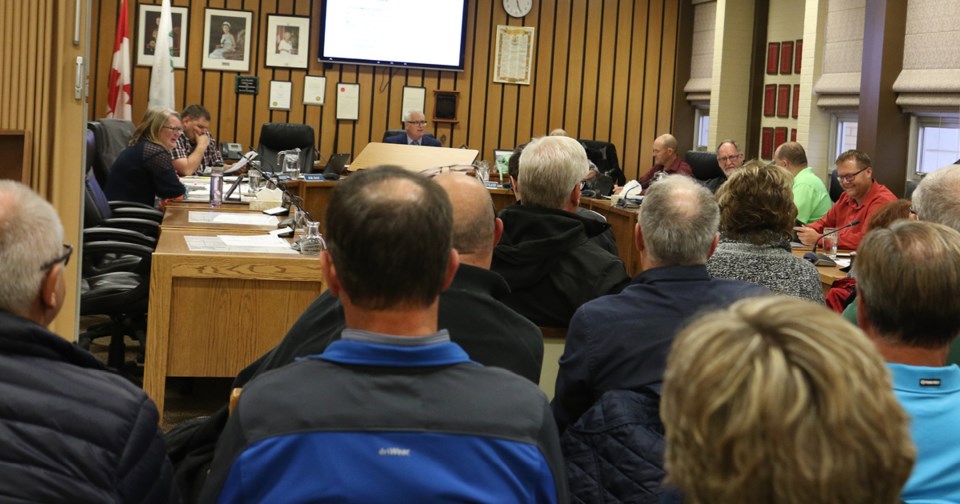By a 4-1 decision, Humboldt council voted in favour of allowing a crematorium at the Malinoski and Danyluik Funeral Home.
At the Oct. 8 special council meeting, Mayor Rob Muench and Councillors Michael Behiel, Larry Jorgenson and Lorne Pratchler voted in favour. Coun. Sandy Weyland voted against.
Councillors Owen Hopfner and Roger Nordick declared they had a conflict of interest and were not present for the discussion or the vote.
All of the council members present said the decision was one of the hardest they had to make at the table.
“This has been probably the most time and energy that myself – and I think a lot of the councillors – have dedicated to any question or any vote that's come across our table,” Muench said.
Frank Carpentieri, Humboldt’s planning co-ordinator, told council that under provincial environmental regulations, a crematorium either had to submit an environmental protection plan like most incinerators or become a member of the Saskatchewan Crematoria Council, which has developed a set of best practices designed to provide the same or greater level of environmental protection.
Malinoski and Danyluik has chosen to join the crematoria council.
The planning co-ordinator also told council the city got in contact with the medical health officer, who said that he would not comment on this particular proposal, but added while the ideal would be a health impact risk assessment – which might not be feasible – a literature review showed that crematorium emissions were below health and regulatory guidelines.
Carpentieri’s recommendation, which was approved, was to approve the project but require Malinoski and Danyluik to follow all of the requirements laid out in the Environmental Health and Protection Act, as well as the requirements set by the environment ministry, be followed.
There were 157 submissions from the public about the proposal. Out of that, 54 per cent were opposed, while 46 per cent were in favour.
Janet Muyres booked time to talk to council about the proposal.
“I wish to emphasize on behalf of the citizens of Water Ridge area and beyond that a lot of work has been done on this matter providing you with volumes of information to consider,” she said. “We urge you to give your sincerest consideration to the overall welfare of the people of Humboldt.”
Council gave a short amount of time for other members of the audience – which filled council chambers – to give their options. Concerns expressed included the location, emissions from the crematorium and possible effects on nearby property values.
Coun. Weyland told council she was concerned about the number of submissions that were against the proposal.
“One thing that tells me that there are many residents, not only that are living directly in the Water Ridge area, but also many residents in the city that are concerned about a crematorium being constructed within city limits,” she said.
“I don't know that I can support this because of the many concerns of the residents.”
Muench said his decision for the proposal came down to the legislation that’s in place that governs crematoriums. He said that there were plenty of communities that had crematoriums in their boundaries and listing 13 during council’s discussion.
He told media after the meeting that he went to Wadena and Melfort, knocking on doors near the local crematoriums to find out what people thought. He found they had no concerns.
“I think by talking to people that are living with them every day, you're going to get an honest opinion from people and that's what I based the majority of my decision on.”
Behiel said he started out skeptical of the proposal.
“The more research that I did, the more people I spoke to, the more communities I contacted, it became less and less of finding a reason as to why we should be against it as opposed to why we should be for it and not stop it.”
Pratchler said health was his main concern when making the decision and that while it was impossible to know the exact effect of a crematorium, he was satisfied with the reports and government officials that concluded the level of emissions were safe. He said he understood how people could be apprehensive, considering that’s where he started.
“But the problem with making a decision on potential threats is that if we use that all the time as our foundation, we would ultimately not make any decisions, so we have to find out what those risks are and where the most important ones are.”
Jorgenson spoke on the proposal last.
“I echo the comments everybody else made, there's been no shortage and information for us to review and it's definitely weighed heavy on all of us. It is not going to be an easy decision.”
He voted in favour of the proposal.
Connie Danyluik, one of the owners of the funeral home, said she was pleased with the decision.
“We're happy that city council looked through everything, did their due diligence and made their decision based on facts,” she said.
Danyluik said the next step for her business was to talk to the manufacturer of the equipment. She said she expects it will be six to eight months before the crematorium is operating.



